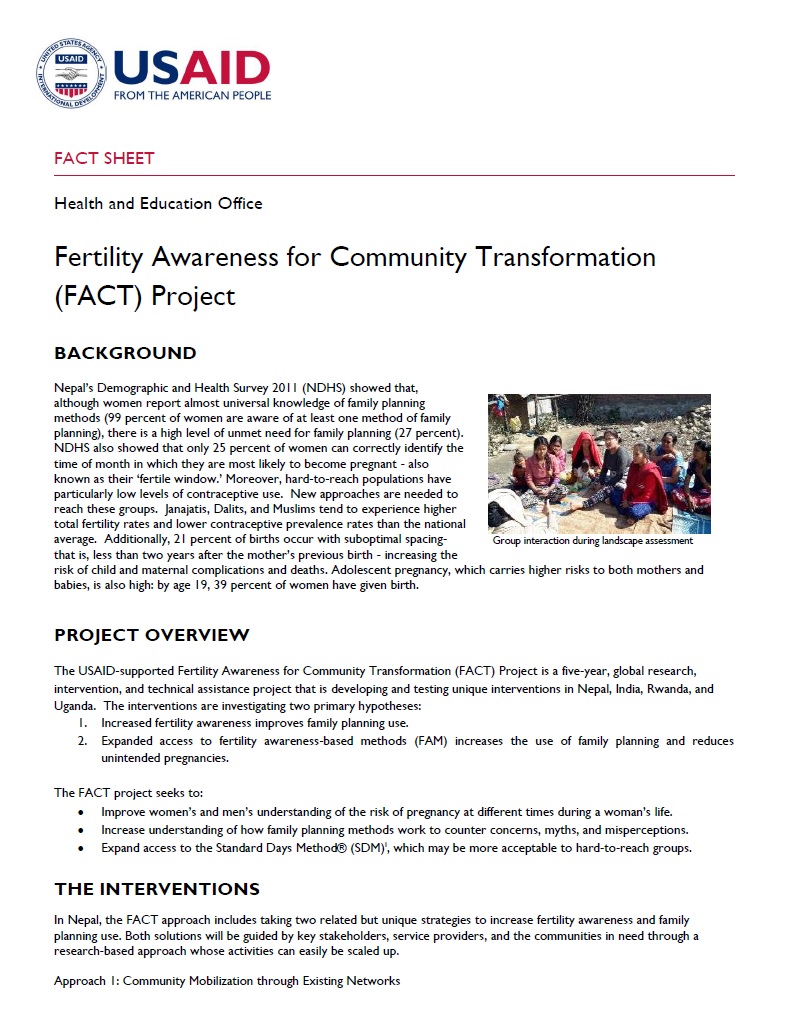Fertility Awareness for Community Transformation (FACT) Project
BACKGROUND
Nepal’s Demographic and Health Survey 2011 (NDHS) showed that, although women report almost universal knowledge of family planning methods (99 percent of women are aware of at least one method of family planning), there is a high level of unmet need for family planning (27 percent). NDHS also showed that only 25 percent of women can correctly identify the time of month in which they are most likely to become pregnant - also known as their ‘fertile window.’ Moreover, hard-to-reach populations have particularly low levels of contraceptive use. New approaches are needed to reach these groups. Janajatis, Dalits, and Muslims tend to experience higher total fertility rates and lower contraceptive prevalence rates than the national average. Additionally, 21 percent of births occur with suboptimal spacing-that is, less than two years after the mother’s previous birth - increasing the risk of child and maternal complications and deaths. Adolescent pregnancy, which carries higher risks to both mothers and babies, is also high: by age 19, 39 percent of women have given birth.
PROJECT OVERVIEW
The USAID-supported Fertility Awareness for Community Transformation (FACT) Project is a five-year, global research, intervention, and technical assistance project that is developing and testing unique interventions in Nepal, India, Rwanda, and Uganda. The interventions are investigating two primary hypotheses:
- Increased fertility awareness improves family planning use.
- Expanded access to fertility awareness-based methods (FAM) increases the use of family planning and reduces unintended pregnancies.
The FACT project seeks to:
- Improve women’s and men’s understanding of the risk of pregnancy at different times during a woman’s life.
- Increase understanding of how family planning methods work to counter concerns, myths, and misperceptions.
- Expand access to the Standard Days Method® (SDM) which may be more acceptable to hard-to-reach groups.
THE INTERVENTIONS
In Nepal, the FACT approach includes taking two related but unique strategies to increase fertility awareness and family planning use. Both solutions will be guided by key stakeholders, service providers, and the communities in need through a research-based approach whose activities can easily be scaled up.
Approach 1: Community Mobilization through Existing Networks
- The Community Mobilization through Existing Networks intervention aims to increase fertility awareness to improve family planning use. Fertility awareness involves both actionable information about fertility throughout life and the ability to apply this knowledge to one’s own circumstances and needs. Applying this information to one’s life requires individual knowledge, personal experience and skills, as well as an environment within the family and community that enables people to undertake appropriate actions.
- Qualitative research in five districts (Pyuthan, Siraha, Rupandehi, Nuwakot and Bajura) will guide the design of simple, effective, and easy-to-diffuse behavior change approaches to increase fertility awareness and use of family planning. Local creative experts will lead the design of a data-based, locally driven intervention. Continued engagement with partners and local officials will ensure the integration of those activities into existing groups/networks, such as mothers’ groups, health facility management committees, and facilitate a rigorous evaluation process.
Approach 2: Roving Auxiliary Nurse Midwife (ANM) and Standard Days Methods (SDM) Integration
- This approach will test the deployment of Roving ANMs to share family planning methods with difficult-to-reach and underserved groups, such as Muslims and the urban poor in Rupandehi district. This testing will be carried out in partnership with the Ministry’s Family Health Division and District Public Health Office and will be implemented in parallel to the fertility awareness activities in Rupandehi that started in 2015 and will continue through 2018. TheSDM method will be integrated into the existing family planning services those offices already provide This research will test the feasibility and cultural acceptability of both SDM and CycleBeads among hard-to-reach groups.
- FACT is investigating local perceptions and demand-side factors to guide marketing, distribution and pricing for CycleBeads. FACT will apply the conclusions derived from this study to guide the development of contextually and culturally appropriate messaging for SDM and CycleBeads, and will shape the packaging and possible price points necessary to ensure a sustainable integration of this family planning method into the mix of family planning methods currently available in Bardiya and Banke, with support from Nepal Contraceptive Retail Sales (CRS), a Nepali social marketing organization.
PROJECT ACTIVITIES
Approach 1:
- Situation assessments
- Formative research to inform the intervention design.
- Intervention design workshop.
- Concept developing and proof of concept testing.
- Piloting of solution, monitoring and evaluation.
Approach 2:
- Formative research
- Capacity building – materials adaptation/preparation and training.
- Hold intervention planning meeting with findings from formative research.
- Piloting of approach.
PLANNED OUTCOME
- Improved use of family planning.








Comment
Make a general inquiry or suggest an improvement.